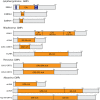The Critical Role of Genome Maintenance Proteins in Immune Evasion During Gammaherpesvirus Latency
- PMID: 30687291
- PMCID: PMC6333680
- DOI: 10.3389/fmicb.2018.03315
The Critical Role of Genome Maintenance Proteins in Immune Evasion During Gammaherpesvirus Latency
Abstract
Gammaherpesviruses are important pathogens that establish latent infection in their natural host for lifelong persistence. During latency, the viral genome persists in the nucleus of infected cells as a circular episomal element while the viral gene expression program is restricted to non-coding RNAs and a few latency proteins. Among these, the genome maintenance protein (GMP) is part of the small subset of genes expressed in latently infected cells. Despite sharing little peptidic sequence similarity, gammaherpesvirus GMPs have conserved functions playing essential roles in latent infection. Among these functions, GMPs have acquired an intriguing capacity to evade the cytotoxic T cell response through self-limitation of MHC class I-restricted antigen presentation, further ensuring virus persistence in the infected host. In this review, we provide an updated overview of the main functions of gammaherpesvirus GMPs during latency with an emphasis on their immune evasion properties.
Keywords: antigen presentation; genome maintenance protein; herpesvirus; immune evasion; viral latency; viral proteins.
Figures


Similar articles
-
Immune evasion by gammaherpesvirus genome maintenance proteins.J Gen Virol. 2010 Apr;91(Pt 4):829-46. doi: 10.1099/vir.0.018242-0. Epub 2010 Jan 20. J Gen Virol. 2010. PMID: 20089802
-
Murine Gammaherpesvirus 68 Expressing Kaposi Sarcoma-Associated Herpesvirus Latency-Associated Nuclear Antigen (LANA) Reveals both Functional Conservation and Divergence in LANA Homologs.J Virol. 2017 Sep 12;91(19):e00992-17. doi: 10.1128/JVI.00992-17. Print 2017 Oct 1. J Virol. 2017. PMID: 28747501 Free PMC article.
-
Latency-Associated Nuclear Antigen E3 Ubiquitin Ligase Activity Impacts Gammaherpesvirus-Driven Germinal Center B Cell Proliferation.J Virol. 2016 Aug 12;90(17):7667-83. doi: 10.1128/JVI.00813-16. Print 2016 Sep 1. J Virol. 2016. PMID: 27307564 Free PMC article.
-
Interplay of Murine Gammaherpesvirus 68 with NF-kappaB Signaling of the Host.Front Microbiol. 2016 Aug 17;7:1202. doi: 10.3389/fmicb.2016.01202. eCollection 2016. Front Microbiol. 2016. PMID: 27582728 Free PMC article. Review.
-
Genetic requirements for the episomal maintenance of oncogenic herpesvirus genomes.Adv Cancer Res. 2002;84:155-74. doi: 10.1016/s0065-230x(02)84005-2. Adv Cancer Res. 2002. PMID: 11883526 Review.
Cited by
-
Wildebeest-Derived Malignant Catarrhal Fever: A Bovine Peripheral T Cell Lymphoma Caused by Cross-Species Transmission of Alcelaphine Gammaherpesvirus 1.Viruses. 2023 Feb 13;15(2):526. doi: 10.3390/v15020526. Viruses. 2023. PMID: 36851740 Free PMC article. Review.
-
Primary Sequence-Intrinsic Immune Evasion by Viral Proteins Guides CTL-Based Vaccine Strategies.Viruses. 2025 Jul 24;17(8):1035. doi: 10.3390/v17081035. Viruses. 2025. PMID: 40872750 Free PMC article. Review.
-
Understanding Metabolic Pathway Rewiring by Oncogenic Gamma Herpesvirus.J Microbiol Biotechnol. 2024 Nov 28;34(11):2143-2152. doi: 10.4014/jmb.2407.07039. Epub 2024 Aug 30. J Microbiol Biotechnol. 2024. PMID: 39403716 Free PMC article. Review.
-
Guinea Pig X Virus Is a Gammaherpesvirus.Viruses. 2025 Aug 5;17(8):1084. doi: 10.3390/v17081084. Viruses. 2025. PMID: 40872798 Free PMC article.
-
Whole genome sequence analysis of equid gammaherpesvirus -2 field isolates reveals high levels of genomic diversity and recombination.BMC Genomics. 2022 Aug 30;23(1):622. doi: 10.1186/s12864-022-08789-x. BMC Genomics. 2022. PMID: 36042397 Free PMC article.
References
-
- Andersson J. (2000). An overview of epstein-barr virus: from discovery to future directions for treatment and prevention. Herpes 7 76–82. - PubMed
-
- Apcher S., Daskalogianni C., Manoury B., Fahraeus R. (2010). Epstein Barr virus-encoded EBNA1 interference with MHC class I antigen presentation reveals a close correlation between mRNA translation initiation and antigen presentation. PLoS Pathog. 6:e1001151. 10.1371/journal.ppat.1001151 - DOI - PMC - PubMed
Publication types
LinkOut - more resources
Full Text Sources
Research Materials

